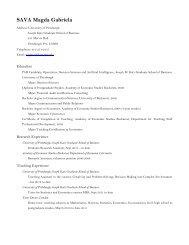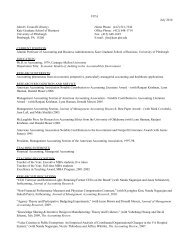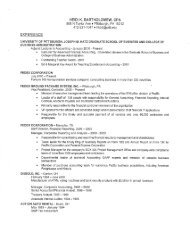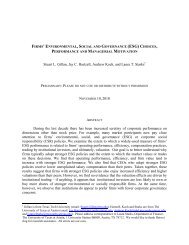Gaming the Float: How Managers Respond to EPS-based Incentives
Gaming the Float: How Managers Respond to EPS-based Incentives
Gaming the Float: How Managers Respond to EPS-based Incentives
You also want an ePaper? Increase the reach of your titles
YUMPU automatically turns print PDFs into web optimized ePapers that Google loves.
targets.<br />
<strong>Managers</strong> change <strong>the</strong> target size in response <strong>to</strong> changes in <strong>the</strong> predictability of those earnings.<br />
Importantly, <strong>the</strong>se effects are stronger for firms with higher incentive compensation, weaker for firms with<br />
low liquidity.<br />
Finally, following an increase in <strong>the</strong> target size, firms meet forecasts more frequently and<br />
earnings management drops.<br />
Our paper is related <strong>to</strong>, but distinct from, <strong>the</strong> broad literature on earnings management. Prior evidence<br />
suggests that earnings management occurs when managers face short term incentives <strong>to</strong> meet or beat a<br />
threshold.<br />
The manager privately observes <strong>the</strong> firm’s earnings, and chooses accruals, investment, s<strong>to</strong>ck<br />
repurchases, or some o<strong>the</strong>r corporate action such that <strong>the</strong> firm’s reported earnings meet <strong>the</strong> threshold. In<br />
contrast, our evidence suggests that managers manage <strong>the</strong> target size not <strong>to</strong> affect <strong>the</strong> current period <strong>EPS</strong>,<br />
but <strong>to</strong> affect <strong>the</strong> ease with which <strong>the</strong> firm will meet future <strong>EPS</strong> thresholds in <strong>the</strong> long run.<br />
No private<br />
information is required by <strong>the</strong> manager for TSM <strong>to</strong> be effective, and markets need not be fooled. TSM<br />
and earnings management are related, however, in <strong>the</strong> sense that TSM is a long-term substitute for earnings<br />
management. By setting <strong>the</strong> target size <strong>to</strong>day, <strong>the</strong> manager is effectively determining <strong>the</strong> amount of earnings<br />
that will need <strong>to</strong> be managed in expectation over multiple periods in <strong>the</strong> future. 9<br />
Our findings contribute most directly <strong>to</strong> <strong>the</strong> literature on <strong>the</strong> choice of earnings management <strong>to</strong>ols. For<br />
example, recent literature focuses on <strong>the</strong> tradeoffs between earnings management <strong>to</strong>ols (e.g.<br />
Cohen and<br />
Zarowin (2010) and Zang (2011)). As noted by Fields et al. (2001), it is important <strong>to</strong> examine <strong>the</strong> combined,<br />
net effect of all earnings management <strong>to</strong>ols used <strong>to</strong>ge<strong>the</strong>r <strong>to</strong> meet <strong>EPS</strong> thresholds. Our results are important<br />
because <strong>the</strong>y suggest that, prior <strong>to</strong> trading off <strong>the</strong>se earnings management <strong>to</strong>ols, managers decide <strong>the</strong> extent<br />
<strong>to</strong> which <strong>the</strong>y will need <strong>to</strong> manage earnings in <strong>the</strong> first place.<br />
Our study highlights an important link between <strong>EPS</strong> reporting and capital market activities through<br />
<strong>the</strong> real effects of s<strong>to</strong>ck splits. Our evidence offers a new explanation for s<strong>to</strong>cks splits <strong>based</strong> on <strong>the</strong> need<br />
for target size management. While previous explanations typically involve signaling motives or s<strong>to</strong>ck price<br />
levels, we show that s<strong>to</strong>ck splits could be a result of managerial concerns regarding <strong>EPS</strong> outcomes. Thus,<br />
we extend <strong>the</strong> prior literature that examines patterns in accounting metrics and <strong>the</strong>ir relationship <strong>to</strong> s<strong>to</strong>ck<br />
splits (e.g. Louis and Robinson (2005)). Fur<strong>the</strong>rmore, a TSM-<strong>based</strong> explanation of s<strong>to</strong>ck splits is consistent<br />
with prior literature that finds that splits follow earnings growth (Lakonishok and Lev (1987), Asquith et al.<br />
(1989)), as well as <strong>the</strong> literature that documents a “nominal price puzzle”(Weld et al. (2009)). We discuss<br />
this in more detail in Section 3.3.<br />
9 Prior literature finds that firms use repurchases (which result in a change <strong>to</strong> <strong>the</strong> quantity of shares) <strong>to</strong> have an accretive<br />
effect on current period <strong>EPS</strong> (e.g. Hribar et al. (2006) and Bens et al. (2003)). Our results do not dispute <strong>the</strong>se findings, but<br />
ra<strong>the</strong>r show that share changes can have long term effects on <strong>EPS</strong> outcomes. TSM is driven primarily through s<strong>to</strong>ck splits and<br />
not through repurchases. We find little evidence that s<strong>to</strong>ck splits have an accretive effect on <strong>EPS</strong> in <strong>the</strong> short run.<br />
5













